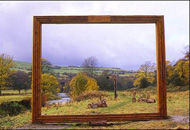Irwell Sculpture Trail
Irwell Sculpture Trail
Overview
The Irwell Sculpture Trail is a major public art initiative which has commissioned work from more that 50 regional, national and international artists in the five year period up to 2002. These include major sculptures by Edward Allington, Ulrich Ruchreim, Stefan Gec and Ian Randall. The Sculpture Trail is based around the well-established 30 mile Irwell Valley Trail, following the River Irwell from Salford Quays, through Bury to Rossendale, and continuing to the river’s source in the wild Pennine Moors north of Bacup.
Background
The project began in 1987 with artists working on relativelysmall-scale commissions in Rossendale to celebrate the landscapeand industrialheritage of the area. The success of this project led the fourlocal authorities responsible for the Irwell Valley – Lancashire County Council, Salford City Council, Bury Metropolitan Borough Council and Rossendale Borough Council – to make a joint bid in March 1996 to the National Lottery Arts Fund via the Arts Council of England. In October 1996, the Arts Council made an award of £2.3 million towards the project, within a total budget of £4.2 million. The four partners have each committedfunding and officer time annually over the project term.
Strategy
The overall objective of the Sculpture Trail is to contribute to the regeneration of the valley by providing a coherent framework for existing and future initiatives, encouraging tourism, increasing access to the countryside from nearby cities, creating employment locally, offering opportunities for education and participation, and improving environmental awareness. The bid included 8 international commissions (4 of £250,000 and 4 of £150,000), 33 six month residencies to produce one work with a five year life span, 6 community projects majoring on educational work, and 3 Graduate Design competitions for recent graduates to produce temporary work and receive mentor support. The strategy is to develop the Trail in geographic sections, creating a groundswell of knowledge and support for major commissions through residencies and community projects, but over the project term to spread works evenly between the three local authority areas. The Bury to Waterfoot stretch was the focus for the first three years, with the higher reaches of the river up to Bacup and below Bury down to Salford Quays receiving attention subsequently.
Management
The Irwell Sculpture Trail is managed jointly by the four partner local authorities which have signed up to a Memorandum of Agreement. Bury Metropolitan Borough Council is the managing authority responsible for overall financial management and employment of the Projects Officer, on behalf of the partnership. The Trail is managed at policy level by the Irwell Sculpture Trail Partnership Committee comprising elected members. and at a strategic level by a Joint Officer Working Group of arts and planning officers. Sub groups reporting to the Joint Officer Steering Group look in detail at art and planning issues, access and development of the path infrastructure, marketing and sponsorship.
Each local authority has its own officer working group to oversee trail maintenance and the management of commissions in its area, and subsequently owns and is responsible for the maintenance of these works, using a 3% ‘top slice’ from the commission budget. The Projects Officer, Cathy Newbery, is responsible for overall co-ordination, financial management, press and marketing strategy and for overseeing artist selection.
Publicity
Colour brochures featuring visitor information and details of the works currently completed and installed have been published as the project has progressed, and a series of walks leaflets giving directions for 4 - 5 mile sections of the Trail, as well as information on the art works are also produced.
Bursary and Training Scheme
In 2000 an annual bursary and training scheme was instigated for young artists in the region wanting to develop their experience in the field of public art. Each year, five recent graduates from art courses in the region have been commissioned to produce a temporary or ephemeral piece of work for a defined stretch of the Trail. In return, they receive a modest bursary and studio space, coupled with advice and support from an artist mentor and a structured programme of training days.
Development
The emphasis of commissions has developed as the project has become established and more confident. The early artist in residence projects produced strong accessible works such as In the Picture by Richard Caink and Remnant Kings by Ian Randall. More recent works have begun to have a sharper edge, such as David Fryer's human scale rat trap at Burrs Country Park, made in stainless steel, which has the words Picnic Area inscribed into the plate of the trap and invites the viewer to question whether the work is a public amenity or a tourist trap.
© Copyright Joanna Morland 2000

